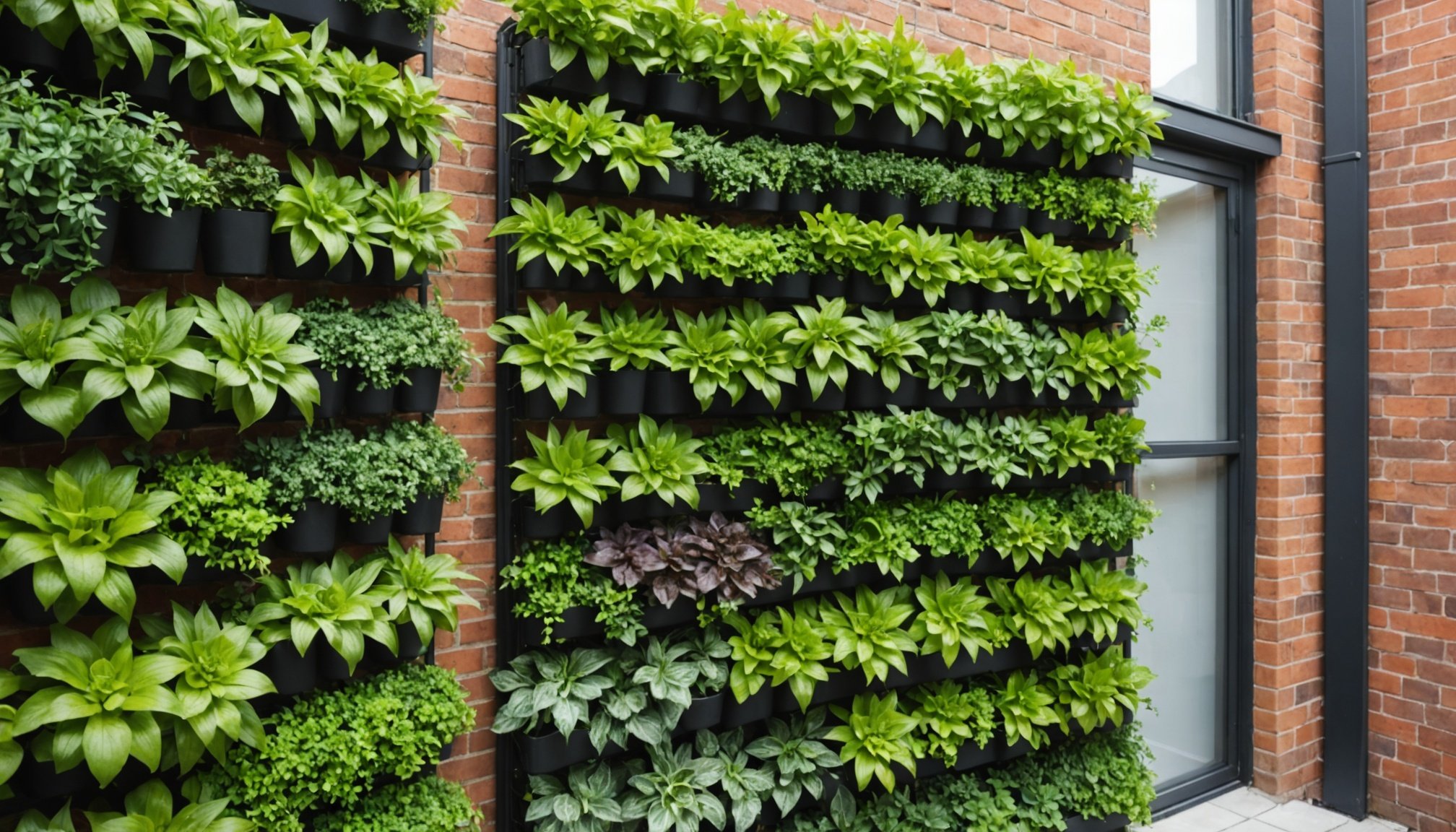Overview of Vertical Gardening
Vertical gardening is an innovative approach to cultivating plants that optimises space by growing upwards rather than outwards. It’s particularly popular among those who are limited by the lack of ground space, making it ideal for terrace homes in the UK. By mounting plants on walls or using freestanding structures, vertical gardening combines aesthetics with functionality, bringing gardens to places where traditional methods might not fit.
One of the main advantages of vertical gardening is its ability to create greenspaces in urban environments. This method is especially beneficial for city residents with limited outdoor areas, such as terraces or balconies. By leveraging vertical spaces, gardeners can enjoy a lush garden without the need for large plots of land. This form of gardening also contributes to better air quality, making the surroundings more pleasant and healthier.
A voir aussi : Essential Guidelines for Creating an Eco-Friendly Green Roof on Inner-City Office Buildings in the UK
The trend of vertical gardening continues to grow in popularity due to its practicality and sustainability. It aligns well with urban living, where space is often at a premium. As more people embrace environmental consciousness and the appeal of green living, vertical gardens offer a sustainable solution that is both visually appealing and supportive of biodiversity.
Suitable Plant Selection for UK Climate
Choosing the right plants for your vertical garden in the UK involves careful climate considerations. The UK’s climate, characterised by mild temperatures and varying levels of rainfall, offers a suitable environment for a variety of hardy plants. These plants can withstand the country’s unpredictable weather, ensuring your vertical garden thrives year-round.
Cela peut vous intéresser : Essential Factors to Think About When Installing a Skylight in UK”s Rain-Prone Coastal Regions
When selecting plants, consider the location’s microclimate and the specific needs of your garden structure. Types of plants popular for their resilience in the UK include ferns, ivy, and certain types of moss. These species not only adapt well to vertical setups but also bring a lush green aesthetic to any space. Additionally, hardy perennials such as lavender and hostas can provide both beauty and durability.
Climate considerations should also include the amount of sunlight and shade in your garden area. Choose shade-tolerant species for less sunny spots and sun-loving plants for areas with ample light exposure. Seasonal planting and rotation are crucial for optimal growth. In spring, consider planting vibrant annuals, while autumn is ideal for introducing perennial elements. This strategy ensures continuous coverage and aesthetic appeal throughout the year, adapting to each season’s challenges.
Structural Support Requirements
When setting up a vertical garden, ensuring a sturdy structural support is crucial for its success and longevity. The right support systems provide essential stability, which prevents plants from being damaged or dislodged due to wind or weight changes.
Vertical garden structures can be crafted from diverse materials like metal, wood, or reinforced PVC to cater to various aesthetic and strength preferences. Metal offers durability and is ideal for outdoor installations where resistance to weather is a priority. Wood, on the other hand, adds a natural look to your garden but requires treatment to prevent rot. PVC is lightweight and weather-resistant, offering a balance between functionality and ease of installation.
Installation guidelines recommend anchoring structures securely to walls or supporting them from the ground with sturdy posts. Techniques such as using brackets, wire trellises, or modular panels can help maintain the garden’s integrity. Ensure even weight distribution when installing to avoid putting excessive stress on any single area. For best results, follow expert installation guidelines and consider consulting a professional to evaluate the specific needs of your space and garden type. This will not only enhance the garden’s stability but also boost its aesthetic appeal and functionality.
Watering Systems for Vertical Gardens
When managing vertical gardens, choosing the right watering system is crucial for plant health and growth. There are various Irrigation Systems designed to fit different needs and setups. Let’s explore some options.
Automated Watering Systems
Automated systems, such as drip irrigation, provide consistent moisture levels, ensuring plants receive the appropriate amount of water without overwatering. These systems can be programmed to water at specific intervals, which is perfect for busy gardeners looking for Self-Watering Options. Although they offer convenience and reduce labour, they may require initial setup effort and cost.
Manual Watering Techniques
For gardeners who prefer a hands-on approach, manual watering methods allow for more control over when and how much water is applied. Quick adjustments can be made based on specific plant needs or weather conditions. However, this method demands more time and regular attention, which could be cumbersome for larger vertical gardens.
Ensuring Proper Drainage and Moisture Retention
Regardless of the chosen method, ensuring adequate drainage and moisture retention is vital. Poor drainage can lead to root rot, while insufficient moisture can stress plants. Incorporating a good soil mix and planting medium that facilitates proper drainage and retains suitable moisture levels will support a thriving vertical garden ecosystem.
Sunlight and Exposure Considerations
Understanding the sunlight requirements of your plants is crucial for ensuring their health and growth. Different plants have varying needs; some thrive in full sun, while others prefer partial shade. When planning your garden, take into account the orientation of your terrace. This aspect influences the amount of sunlight your plants will receive throughout the day. A south-facing garden, for instance, typically enjoys the most sunlight, making it ideal for sun-loving plants.
Assessing your garden orientation helps in identifying which areas receive maximum light and which parts might require additional support. For example, east-facing terraces get morning light, which is less intense and more suitable for tender plants.
To optimize light exposure, consider the following tips:
- Position sun-loving plants in spots that receive prolonged sunlight, such as the southern or western parts of your terrace.
- Use reflective surfaces to bounce light into shaded areas.
- Incorporate plant stands or wall planters to elevate light-needy plants above potential shade barriers.
By carefully assessing your garden’s orientation and understanding your plants’ lighting needs, you can create an environment where your plants thrive beautifully.
Maintenance Tips for Vertical Gardens
Taking care of vertical gardens requires attentive garden maintenance and effective care practices. The unique structure of a vertical garden means that routine tasks are slightly different compared to traditional gardens. Regular seasonal upkeep ensures your vertical garden remains healthy and vibrant throughout the year.
Routine Maintenance Tasks
Routine maintenance tasks are essential. Focus on maintaining the proper water levels, which are crucial for plants in vertical gardens because they dry out more quickly than ground gardens. Check the integrity of your support structures, ensuring they are stable and secure.
Managing Pests and Diseases
Pests and diseases can affect vertical gardens just like any other. Effective management includes regular inspections to catch issues early. Use organic pesticides and encourage beneficial insects like ladybugs, which are natural pest controllers.
Seasonal Care and Adjustments
Seasonal adjustments can significantly enhance the health of your vertical garden. In winter, consider insulating the base to protect roots from cold. During hotter months, increase watering frequency to match the evaporation rate. Seasonal upkeep ensures that each plant thrives in its respective season, adapting to climate changes with ease. Remember, a proactive approach in maintenance is the key to a flourishing vertical garden.
Legal Regulations and Building Codes
When considering installing a vertical garden in the UK, it’s important to be aware of the various regulations and permissions involved. These can vary significantly by location, so understanding local planning permissions is critical. In many areas, planning permissions may be required, especially if the vertical garden affects the structural integrity of a building or is visible from the street.
To determine if your project requires approvals, contact your local council. They can guide you through the necessary steps and regulations that apply to your specific case. If you’re part of a Homeowners Association (HOA) or similar body, their community guidelines may also impact what you can do. These guidelines might have specific rules regarding the aesthetics or material use that need to be considered.
Navigating these aspects involves a bit of research and possibly discussion with your neighbours to ensure compliance. Understanding both legal requirements and community expectations will result in smoother project execution. Make sure to review any community guidelines carefully and plan accordingly to foster good relations within your community while also protecting your investment in your home.
Visual Examples and Inspiration
Vertical gardens have become an increasingly popular way to bring nature into urban environments, offering both aesthetic appeal and practical benefits. In the UK, several successful installations showcase the variety and creativity possible. For example, the Edgware Road Tube Station in London features a vibrant living wall that not only enhances the station’s design but also improves air quality and reduces noise pollution for commuters.
Design inspiration can be drawn from these examples, highlighting how vertical gardens can transform spaces. From simple herb walls in small urban apartments to grandiose green facades on commercial buildings, the possibilities are vast. Some innovative design ideas include integrating aesthetic ideas like spiraling plant patterns or mixing colours to create a living artwork.
To cultivate your own vertical garden vision, various resources offer plenty of design inspiration. Magazines, websites, and social media platforms such as Pinterest or Instagram are treasure troves of aesthetic ideas. Additionally, consulting with professional landscape designers or attending home and garden shows can provide insight and practical tips for your project. Embracing these innovative concepts can turn any vertical space into an inspiring oasis.
Local Resources for Materials and Plants
Gardeners in the UK can harness the benefits of local resources when sourcing quality plants and materials for their green spaces. Procuring items from local suppliers not only supports the community but also reduces environmental impact through decreased transportation emissions.
For the best results, consider visiting well-regarded plant nurseries and garden centers, where you can assure the quality and variety of plants. These establishments often have knowledgeable staff who can provide valuable advice tailored to your specific needs and conditions. Among popular choices are Clifton Nurseries in London and the RHS Garden Wisley’s Plant Centre, known for their extensive selections and expertise.
Beyond physical locations, online resources and communities offer additional support. Websites dedicated to regional gardening offer guides and forums where fellow gardeners share experiences and tips. Engaging with these communities can provide insights into tackling common challenges and optimizing your garden using locally-sourced materials.
Whether you’re a beginner or a seasoned gardener, leveraging these garden resources ensures a sustainable approach to gardening. By choosing nearby suppliers and expert nurseries, you not only curate a bountiful garden but also contribute positively to your environment and community.






